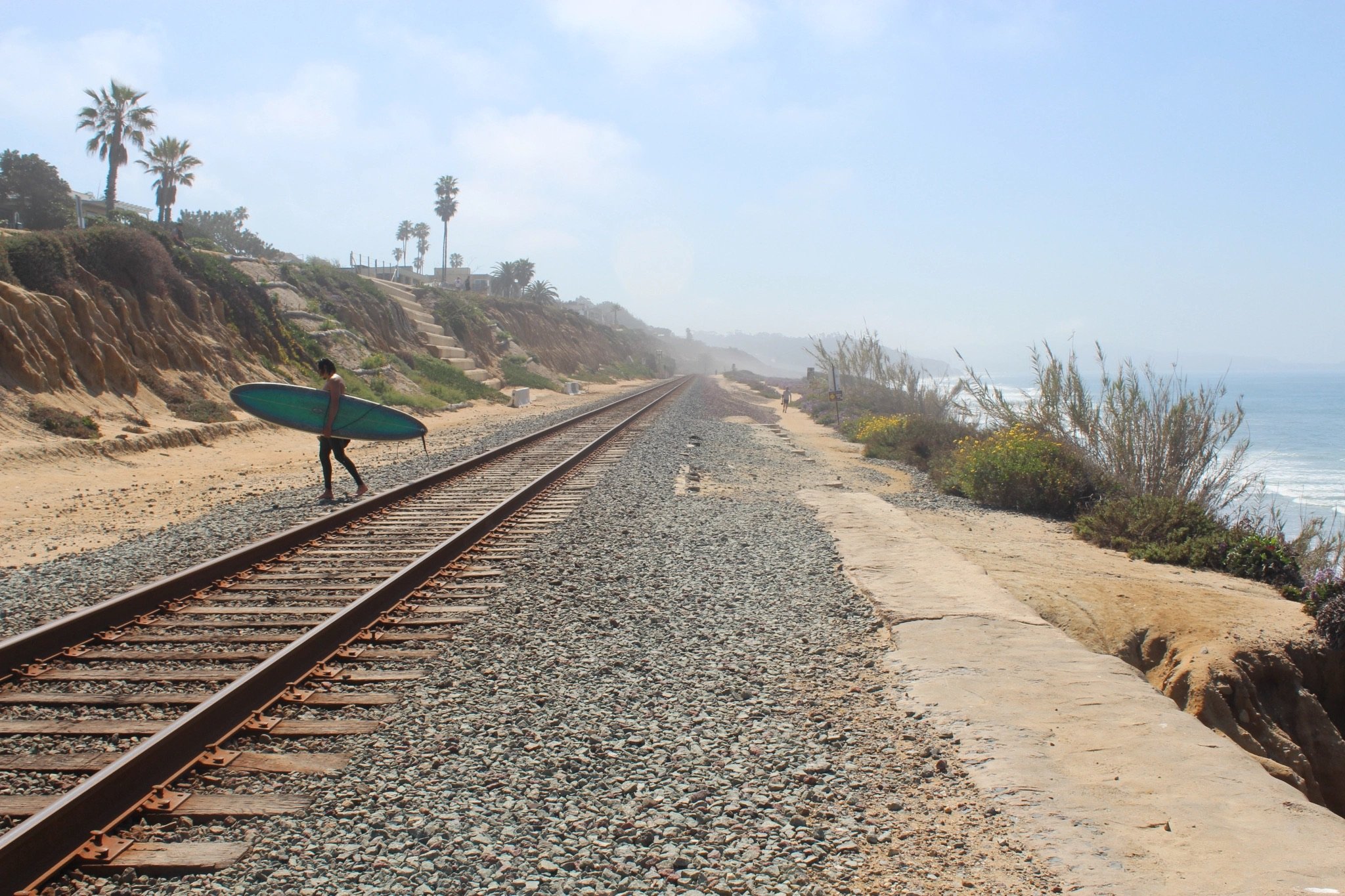
06.16.23
Recent Federal Board Decision Keeps Del Mar Railroad Relocation on Track
By Mitch SilversteinSurfrider has long advocated for realigning 1.7 miles of the LOSSAN rail corridor off of Del Mar’s eroding coastal bluffs. Last month, we won a partial victory in this long-term campaign when the federal Surface Transportation Board (STB) declined North County Transit District’s (NCTD) petition for exemption from state environmental laws for bluff stabilization work along the rail corridor.1 If granted, NCTD’s petition would have had serious consequences. In addition to potentially undermining the regional commitment to move the train tracks, it could have set a dangerous precedent that coastal rail projects statewide no longer need to be consistent with the California Coastal Act.
Although Surfrider opposes coastal armoring projects because they negatively affect our beaches, we supported the California Coastal Commission’s conditional concurrence of the Del Mar Bluff Stabilization Phase 5 (DMB5) project last June because it memorialized SANDAG’s commitment to move the railroad. DMB5 went before the Coastal Commission thanks to the federal Coastal Zone Management Act, which requires federally-funded projects to be consistent with state coastal laws where they occur. As part of its federal consistency determination, the Commission required SANDAG to remove the DMB5 seawalls within 30 years once the railroad is moved. They also required SANDAG to provide beach access improvements as mitigation for the loss of public beach space that the seawalls will cause. Surfrider supported these conditions.
DMB5 seawalls will mimic the removable design of those recently added during emergency repairs
NCTD above the law?
SANDAG, the agency responsible for the bluff stabilization work, accepted the Coastal Commission’s terms. But NCTD, the owner/operator of the railroad in Del Mar, did not. They had already petitioned STB, an independent federal agency tasked with overseeing interstate rail commerce, to ask for a broad, categorical exemption from state and local environmental review for rail safety projects in the coastal zone.2 Their petition came in response to the City of Del Mar’s opposition to previous bluff stabilization work in 2019, along with an NCTD safety fencing project that many residents fiercely opposed. Members of the public were rightly concerned about how these projects would affect the beach and their access to it.
NCTD’s petition prompted immediate opposition from Del Mar, Surfrider, and the Coastal Commission. A 3-year period of uncertainty ensued, marked by numerous letters and replies by all parties to STB, and several lawsuits over the fencing project. The ideological battle continued while the Coastal Commission reviewed SANDAG’s DMB5 project last June, where NCTD doubled down on its claim that their responsibility to ensure reliable rail service could not be harmonized with the coastal resource protections in the Coastal Act. They opposed any commitment to relocate the rail in the next 50 years, argued that the “beach access conditions have absolutely no relationship to how the Project will impact coastal access in this area,” and even threatened to bar access to their right-of-way for SANDAG to perform construction.3
Damage from late 2019 inched perilously close to the tracks
Full steam ahead
Since then, federal and state leaders have come out in support of the railroad realignment plan as the best (and only) long term option to ensure the future of rail service along the LOSSAN corridor in San Diego County. Not long after DMB5’s approval, state leaders allocated $300m for SANDAG to study new route alternatives. While the project will take decades and cost billions, it finally has momentum.
Rather than potentially thwart that momentum, STB’s recent decision allows the process to continue as SANDAG and the Coastal Commission agreed. Equally important, it shuts the door - for now, at least - on weakening coastal protections for rail projects statewide. Surfrider would have preferred a ruling that actively legitimized one of our main arguments: that state environmental laws (i.e. the Coastal Act) must apply because most of the DMB5 construction will take place on public lands outside of NCTD’s property (i.e. the seawalls on public beach).4
STB mentioned our argument in their decision, but ultimately declined NCTD’s petition because federal consistency review had already been completed, and because SANDAG and NCTD later reached agreement that the project could go forward so long as SANDAG fronted the bill. Still, STB dismissed NCTD’s claim that preemption was necessary to prevent future projects from being disrupted, which reinforces existing precedent that consistency review is required under federal law. Meanwhile, the two associated lawsuits against NCTD’s safety fencing project, one from Del Mar residents and one from the Coastal Commission, will be decided in the state courts.
DMB5 construction will begin soon to stabilize the railroad until it can be relocated. And in late 2022, SANDAG did a round of public outreach on several design options for the required coastal access improvements, which culminated in a presentation to the Del Mar City Council. A final report is forthcoming, but you can see the designs HERE.

A railroad undercrossing at 7th-8th St. is one design option that Del Mar supports (source: SANDAG)
Surfrider is thankful that plans to move the train from Del Mar’s bluffs remain on track. With similar erosion issues plaguing a larger stretch of coastal rail corridor in San Clemente, the Del Mar project’s trajectory serves as an example for Orange County to follow. It will all need to be moved eventually as sea levels rise in the next century. For the sake of our beaches and coastal access, the sooner the better.
1Surface Transportation Board Decision, NCTD Petition for Declaratory Order, 5.28.23
2NCTD Verified Petition for Declaratory Order, 8.28.20
3NCTD Petition for Declaratory Order, Second Supplemental Status Update, 6.14.23
4Updated Opposition Statement from Surfrider to STB, 7.25.22. “Federal and state law must apply to ensure appropriate management of coastal resources outside of NCTD’s Right-of-Way, just as it has for past rail corridor projects along Del Mar’s bluffs.”


